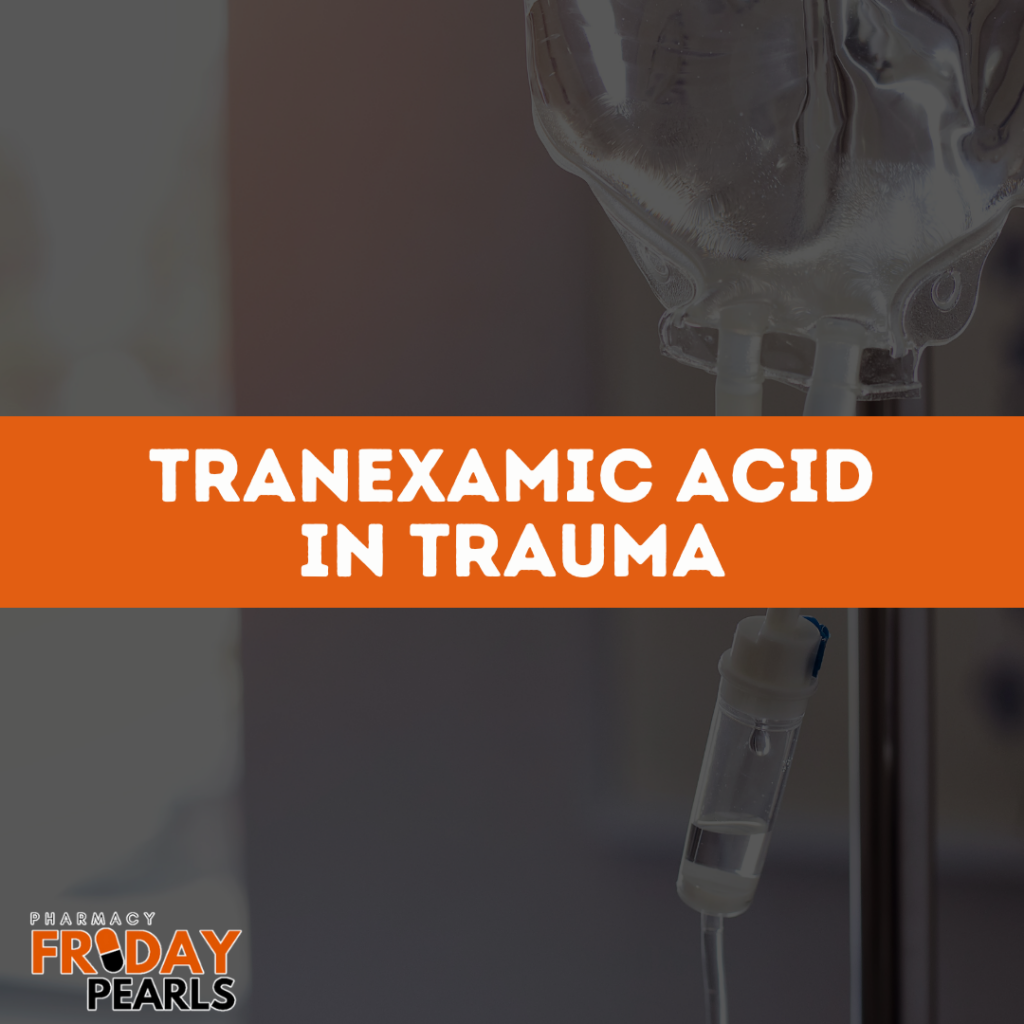Seizure Prophylaxis in Traumatic Brain Injury by Jordan Spurling
Introduction
- Traumatic brain injury (TBI) is a leading cause of death and disability in the United States.
- The Brain Trauma Foundation updated its guidelines for the management of severe TBI in 2016; however, there remains a lack of randomized clinical trials addressing many aspects of care in TBI patient.
- The incidence of early post-traumatic seizures may be as high as 30 percent in patients with severe TBI
- Antiseizure medications in acute management of TBI has been shown to reduce incidence of early seizures but has not been shown to prevent later development of epilepsy
- Prevention of early seizures is beneficial in order to prevent status epilepticus, further aggravating systemic injury.
- The Brain Trauma Foundation guidelines recommend phenytoin for early post-traumatic seizures for 7 days following injury, however levetiracetam is commonly used in this setting.
Pharmacology
| Phenytoin | Valproic Acid | Levetiracetam | Lacosamide | ||
| Dose | Loading dose: 17 to 20 mg/kg IV (max dose 2 g) Maintenance dose: 100 mg every 8 hours or 5 mg/kg/day divided q8h (individual doses not to exceed 400 mg) Duration not to exceed 7 days | 10 – 15 mg/kg/day | Loading dose: 20 mg/kg IV infused over 5-20 min Maintenance dose: 1 g IV over 15 min every 12 hours for 7 days (may be increased to 1.5 g q12) | 50 – 100 mg IV twice daily May give loading dose of 200 mg | |
| Administration | IV piggyback rate of ≤50 mg/minute | IV piggyback over 60 minutes at a rate ≤20 mg/minute | IV push or piggyback over 5-20 min | Bolus: May be administered undiluted at ≤80 mg/minute Infusion: over 30 to 60 minutes | |
| PK/PD | Onset: 30 min – 1 hour Half-life:10 to 12 hours. | Peak: <1 hour Half-life:9 to 19 hours | Peak: 5-30 minutes Half-life: 6-8 hours | Peak: < 1 hour Half-life: ~13 hours | |
| Adverse Effects | Hematologic effects, cardiovascular effects, CNS effects, gingival hyperplasia, hepatotoxicity | CNS effects, hematologic effects, hepatotoxicity, encephalopathy, pancreatitis | CNS depression, hypersensitivity reactions, psychiatric and behavioral abnormalities, increased blood pressure, asthenia | Cardiac arrhythmias including bradycardia, AV block, CNS effects | |
| Warnings | Vesicant, acute toxicity | Not recommended for post-traumatic seizure prophylaxis in patients with acute head trauma | Caution in renal impairment. | Administer loading doses under medical supervision due to increased incidence of CNS adverse reactions | |
Guideline Recommendation
| Journal | Recommendations | |
| Guidelines for the Management of Severe Traumatic Brain Injury, Fourth Edition – 2017 | Phenytoin is recommended to decrease the incidence of early PTS (within 7 d of injury), when the overall benefit is thought to outweigh the complications associated with treatment. There is insufficient evidence to recommend levetiracetam compared with phenytoin regarding efficacy in preventing early post-traumatic seizures and toxicity. | |
Overview of Evidence
| Author, year | Design/ sample size | Intervention & Comparison | Outcome |
| Temkin, 1990 | A randomized, double-blind study N = 404 | Phenytoin vs Placebo | Within the first week 3.6% of phenytoin patients experienced seizure compared to 14.2% (p<0.001) Between day 8-1 year 21.5% of patients in phenytoin group experienced seizure compared to 15.7% in placebo group Phenytoin is effective in reducing seizures within the first 7 days after severe head injury |
| Young, 2004 | Randomized, Double-Blinded, Placebo- Controlled Trial in pediatric patients (age < 16 yo) N = 102 | Phenytoin vs Placebo for prevention of early posttraumatic seizures | During the 48-hour observation period, 3 of 46 (7%) patients in the phenytoin group and 3 of 56 (5%) patients in the placebo group experienced a posttraumatic seizure. No significant difference in survival or neurologic outcome between the two groups. Phenytoin did not significantly reduce the rate of posttraumatic seizures at 48 hours, neurologic outcomes, or overall survival at 30 days. |
| Jones, 2008 | Prospective, single-center trial N = 32 | Phenytoin vs Levetiracetam in patients with severe TBI (GCS 3-8) | Patients treated with levetiracetam and phenytoin had equivalent incidence of seizure activity (p = 0.556) Patients receiving levetiracetam had a higher incidence of abnormal EEG findings (p = 0.003). Levetiracetam is as effective as phenytoin in preventing early posttraumatic seizures but is associated with an increased seizure tendency on EEG |
| Temkin, 1990 | A randomized, double-blind study N = 404 | Phenytoin vs Placebo | Within the first week 3.6% of phenytoin patients experienced seizure compared to 14.2% (p<0.001) Between day 8-1 year 21.5% of patients in phenytoin group experienced seizure compared to 15.7% in placebo group Phenytoin is effective in reducing seizures within the first 7 days after severe head injury |
| Szaflarski, 2009 | Prospective, single-center, randomized, single-blinded comparative trial N = 52 | Levetiracetam vs Phenytoin in patients with severe traumatic brain injury (sTBI) or subarachnoid hemorrhage | Levetiracetam patients experienced better long-term outcomes than those on phenytoin. No differences between groups in seizure occurrence during cEEG (levetiracetam 5/34 vs. phenytoin 3/18; P = 1.0) or at 6 months (levetiracetam 1/20 vs. phenytoin 0/14; P = 1.0), or mortality (levetiracetam 14/34 vs. phenytoin 4/18; P = 0.227). Lower frequency of worsened neurological status (P = 0.024), and gastrointestinal problems (P = 0.043) in levetiracetam group Levetiracetam improved long-term outcomes of compared to phenytoin with less ADRs and may be an alternative. |
| Chi-yuan, 2010 | Retrospective, cohort study N = 171 | Sodium Valproate vs Placebo in early posttraumatic seizures in traumatic brain injury (TBI) patients. | No patients who received sodium valproate treatment experienced seizures; however, this was not statistically significant. Sodium valproate is effective in decreasing the risk of early posttraumatic seizures in severe TBI patients |
| Inaba, 2012 | Prospective, comparative study N = 1,191 | Levetiracetam vs Phenytoin for prevention of early post-traumatic seizures | No difference in seizure rate (1.5% vs.1.5%, p = 0.997) No difference between levetiracetam and phenytoin in the prevention of early post traumatic seizures, mortality or ADRs in patients following TBI. |
| Caballero, 2013 | Multicenter retrospective analysis N = 90 | Phenytoin vs Levetiracetam in TBI with at least one day of EEG monitoring | Prevalence of EEG-confirmed seizure activity was similar between the levetiracetam and phenytoin groups (28% vs 29%; p = .99). The median daily cost of levetiracetam therapy was $43 compared to $55 for phenytoin therapy and monitoring (p = .08). Levetiracetam may be an alternative treatment option for seizure prevention inTBI patients in the ICU while also providing lower costs for drug therapy and monitoring. |
| Kruer, 2013 | Retrospective observational study N = 109 | Phenytoin vs Levetiracetam in patients with a TBI and GCS < 8. | 79 out of 81 (98%) patients admitted between 2000 and 2007 received PHT, whereas 18 of 28 (64%) patients admitted between 2008 and 2010 received LEV. 1 patient out of 89 receiving phenytoin had a posttraumatic seizure and 1 patient out of 20 recieving levetiracetam experiences a posttraumatic seizure Only 2 patients experienced posttraumatic seizure after receiving AED, indicating low incidence of posttraumatic seizures. |
| Gabriel, 2014 | Single-center, prospective cohort analysis N = 19 | Phenytoin vs Levetiracetam after severe TBI | No difference in Glasgow Outcome Scale–Extended score assessed ≥6 months after injury No difference in early seizures (p = 0.53) or late seizures (p = 0.53) Higher days with fever experienced in the hospital in the phenytoin group. Long-term functional outcome in patients who experienced a TBI was not affected by treatment with PHT or LEV. |
| Khan, 2016 | Randomized controlled trial N = 154 | Phenytoin vs Levetiracetam in patients with moderate to severe head trauma | Phenytoin was effective in preventing early post traumatic seizures in 73 of 77 patients (94.8%) Levetiracetam effectively controlled seizures in 70 of 77 patients (90.95%) cases No statistically significant difference in the efficacy of Phenytoin and Levetiracetam in prophylaxis of early post-traumatic seizures in moderate to severe traumatic brain injury. |
Conclusions
- The Brain Trauma Foundation guidelines recommend phenytoin for early post-traumatic seizures for 7 days following injury, however levetiracetam is commonly used in this setting.
- In recent studies, lacosamide and levetiracetam showed no difference compared to phenytoin in prevention of early post-traumatic seizures following TBI
- Less side effects were associated with levetiracetam and lacosamide compared to phenytoin when used in seizure prophylaxis in TBI.
References
- Micromedex [Electronic version].Greenwood Village, CO: Truven Health Analytics. Retrieved October 17, 2023, from http://www.micromedexsolutions.com/
- Carney N, Totten AM, O’Reilly C, et al. Guidelines for the Management of Severe Traumatic Brain Injury, Fourth Edition. Neurosurgery. 2017;80(1):6-15. doi:10.1227/NEU.0000000000001432
- Frey LC. Epidemiology of Posttraumatic Epilepsy: A critical review. Epilepsia. 2003;44(s10):11-17. doi:10.1046/j.1528-1157.44.s10.4.x
- Micromedex [Electronic version].Greenwood Village, CO: Truven Health Analytics. Retrieved October 13, 2023, from http://www.micromedexsolutions.com/
- Temkin NR, Dikmen SS, Wilensky AJ, Keihm J, Chabal S, Winn HR. A randomized, double-blind study of phenytoin for the prevention of post-traumatic seizures. N Engl J Med. 1990;323(8):497-502. doi:10.1056/NEJM199008233230801
- Young KD, Okada PJ, Sokolove PE, et al. A randomized, double-blinded, placebo-controlled trial of phenytoin for the prevention of early posttraumatic seizures in children with moderate to severe blunt head injury. Annals of Emergency Medicine. 2004;43(4):435-446. doi:10.1016/j.annemergmed.2003.09.016
- Jones KE, Puccio AM, Harshman KJ, et al. Levetiracetam versus phenytoin for seizure prophylaxis in severe traumatic brain injury. Neurosurg Focus. 2008;25(4):E3. doi:10.3171/FOC.2008.25.10.E3
- Szaflarski JP, Lindsell CJ, Zakaria T, Banks C, Privitera MD. Seizure control in patients with idiopathic generalized epilepsies: EEG determinants of medication response. Epilepsy Behav. 2010;17(4):525-530. doi:10.1016/j.yebeh.2010.02.005
- Ma CY, Xue YJ, Li M, Zhang Y, Li GZ. Sodium valproate for prevention of early posttraumatic seizures. Chin J Traumatol. 2010;13(5):293-296.
- Inaba K, Menaker J, Branco BC, et al. A prospective multicenter comparison of levetiracetam versus phenytoin for early posttraumatic seizure prophylaxis. J Trauma Acute Care Surg. 2013;74(3):766-773. doi:10.1097/TA.0b013e3182826e84
- Caballero GC, Hughes DW, Maxwell PR, Green K, Gamboa CD, Barthol CA. Retrospective analysis of levetiracetam compared to phenytoin for seizure prophylaxis in adults with traumatic brain injury. Hosp Pharm. 2013;48(9):757-761. doi:10.1310/hpj4809-757
- Kruer RM, Harris LH, Goodwin H, et al. Changing trends in the use of seizure prophylaxis after traumatic brain injury: A shift from phenytoin to Levetiracetam. Journal of Critical Care. 2013;28(5). doi:10.1016/j.jcrc.2012.11.020
- Gabriel WM, Rowe AS. Long-term comparison of GOS-E scores in patients treated with phenytoin or levetiracetam for posttraumatic seizure prophylaxis after traumatic brain injury. Ann Pharmacother. 2014;48(11):1440-1444. doi:10.1177/1060028014549013
- Khan SA, Bhatti SN, Khan AA, et al. Comparison Of Efficacy Of Phenytoin And Levetiracetam For Prevention Of Early Post Traumatic Seizures. J Ayub Med Coll Abbottabad. 2016;28(3):455-460.
- Kwon YH, Wang H, Denou E, et al. Modulation of Gut Microbiota Composition by Serotonin Signaling Influences Intestinal Immune Response and Susceptibility to Colitis. Cell Mol Gastroenterol Hepatol. 2019;7(4):709-728. doi:10.1016/j.jcmgh.2019.01.004



Responses